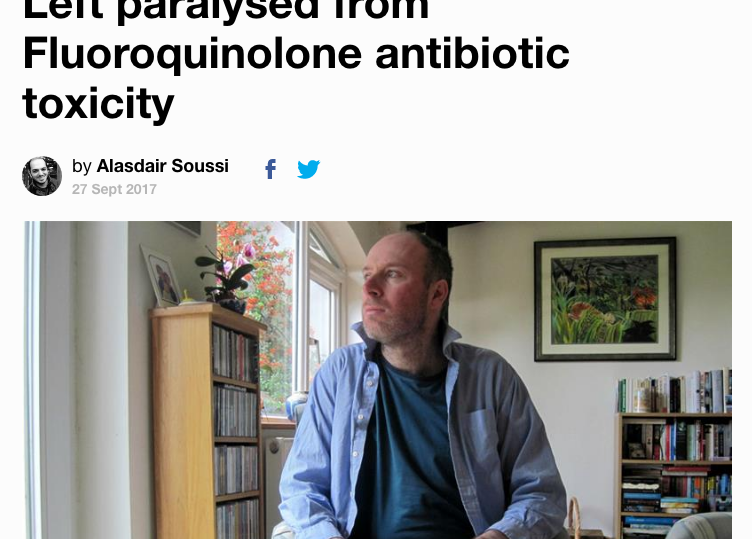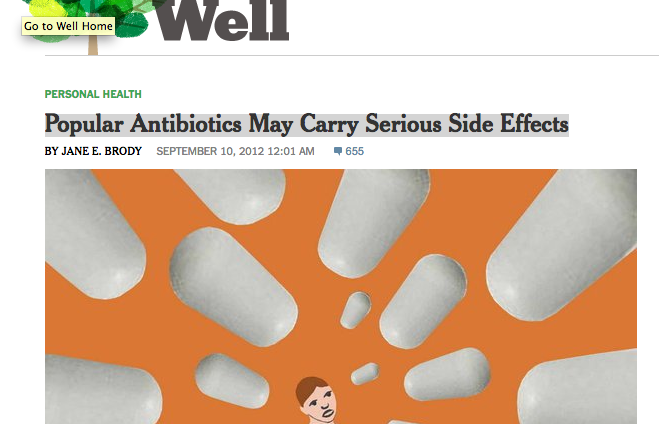It takes a tremendous amount of strength and bravery to publicly tell one’s personal story of chronic illness and iatrogenic injury, and I am so grateful to those who have told their stories of fluoroquinolone toxicity to the media.
There is often shame around chronic and mysterious illness, and that shame and desire to hide what is “wrong,” often leads people to stay silent about their illness. I commend everyone who has overcome shame associated with illness, and who has spoken out about the harm that fluoroquinolones have caused. (And I also commend those who know that there is nothing to be ashamed of, who shout about what happened as loudly as possible.)
I wanted to take this chance, and use this post, to publicly thank all of the brave and wonderful people who have reached out to the media to tell their stories. They deserve thanks. With every story that gets published in the media (whether in a newspaper, on a website, or on television) comes greater awareness of the dangers of fluoroquinolones, and more compassion for those suffering from fluoroquinolone toxicity.
There are more than 150 media stories about fluoroquinolone toxicity published on the Links & Resources page of Floxiehope.com. Each media story features a person (or two, or more) who has been hurt by Cipro/ciprofloxacin, Levaquin/levofloxacin, Avelox/moxifloxacin, or Floxin/ofloxacin. In each media story, a person got vulnerable, and opened him or herself up to risk of derision and rejection from naysayers, so that she or he can speak the truth about the harm that fluoroquinolones cause. Speaking out is not an easy thing to do, and, from the bottom of my heart, I thank everyone who has been featured in a media story.
It would be impossible for me to recognize everyone individually – without a doubt, I would leave someone out – but I want to highlight a few media stories that have been particularly impactful, and the people who made them possible.
Richard Pyne’s story was highlighted in the article “Left paralysed from Fluoroquinolone antibiotic toxicity” that was published on Al Jazeera. “Left paralysed from Fluoroquinolone antibiotic toxicity” notes that:
Richard Pyne’s health reflects a man much older than his 42 years. His world is today little more than the confines of his mother’s house, which he moved to so she could take on the role of his primary carer. Until recently, the Briton lived in his own flat and held down a job, but now, he says, he struggles to walk, to sleep and to live a day-to-day life that doesn’t involve some form of physical distress.
“My health and my life have been destroyed,” said Pyne, speaking to Al Jazeera from his home in Norwich, in England’s East Anglia.
Pyne blames his health crisis, which also includes skin and respiratory complaints, on ciprofloxacin, an antibiotic of the fluoroquinolone drug class. He was prescribed ciprofloxacin – or cipro, for short – to treat prostatitis in January 2016. Far from giving him the new start he wanted, however, the cipro, says Pyne, began to ravage his body within weeks of taking it leaving him effectively housebound.
“I can’t walk properly and haven’t been able to walk properly for over a year,” said Pyne. “My elbows, knees, ankles, pelvic joints, just snap and pop – even my neck.”
Richard’s story makes the article poignant, accessible, and real to the people who read it. The article is impactful because of Richard’s story. Thank you, Richard, for telling your story.
In the PBS Newhour story “Certain Antibiotics Spur Widening Reports of Severe Side Effects” both Jenne Wilcox and John Fratti tell their stories of permanent harm done to them by fluoroquinolone antibiotics:
JENNE WILCOX, patient: I couldn’t even hold my head up. And I was bedridden for over a year. And when I say that, I mean, I couldn’t even get myself out of bed to get into my wheelchair to go use the restroom. I had to be picked up out of bed.
JOHN FRATTI: It caused nerve damage, tendon damage and central nervous system damage. Central nervous system damage is — is brain damage.
JOHN FRATTI: I have lost my job. I have lost over a quarter of a million dollars in lost wages. I have spent about $30,000 out of my own pocket in medical and insurance costs, haven’t received a dime back for this.
“Certain Antibiotics Spur Widening Reports of Severe Side Effects” shows both Jenne Wilcox and John Fratti in vulnerable, deeply personal, situations, and it illustrates the pain, disability, and loss that these drugs cause. They are both appreciated for putting themselves out there, in one of the first news stories about fluoroquinolone toxicity (it was aired in 2011).
In the New York Times article, “Popular Antibiotics May Carry Serious Side Effects” the story of Lloyd Balch is featured. It is noted that:
In addition to being unable to walk uphill, climb stairs or see clearly, his symptoms included dry eyes, mouth and skin; ringing in his ears; delayed urination; uncontrollable shaking; burning pain in his eyes and feet; occasional tingling in his hands and feet; heart palpitations; and muscle spasms in his back and around his eyes. Though Mr. Balch’s reaction is unusual, doctors who have studied the side effects of fluoroquinolones say others have suffered similar symptoms.
Three and a half months after he took that second pill, these symptoms persist, and none of the many doctors of different specialties he has consulted has been able to help. Mr. Balch is now working with a physical therapist, but in a phone consultation with Dr. David Flockhart, an expert in fluoroquinolone side effects at the Indiana University School of Medicine, he was told it could take a year for his symptoms to resolve, if they ever do disappear completely.
Thank you, Lloyd, for telling your story! “Popular Antibiotics May Carry Serious Side Effects” was published in 2012, and it has been highly influential.
Roughly 100 local news stories about fluoroquinolone dangers have aired in the last couple years. Each news story features interviews with victims of fluoroquinolones, and everyone who was featured in a local news-story is brave, wonderful, and appreciated! This post would be ridiculously long if I grabbed quotes from each local news story about fluoroquinolone toxicity, and I would undoubtedly forget several people, but I want to give a broad shout-out of thanks to everyone who has been featured on a local news story about fluoroquinolone toxicity. With each of the local news stories came more awareness and compassion, and it led us closer to meaningful change in how fluoroquinolones are perceived and prescribed.
A particularly impactful local news story is “Local woman says popular antibiotic killed her husband” which aired on WSB TV 2 Atlanta. It was shared thousands of times on social media, and I heard that Levaquin prescriptions in Atlanta dropped significantly for months after it aired. You can see “Local woman says popular antibiotic killed her husband” below:
Kathy Dannelly is incredibly brave for sharing her, and Chris’s, story, and her advocacy is appreciated! Jeff Stephens is also brave and his contribution to the news story above is also appreciated!
All the stories of harm done by fluoroquinolones are valuable, important, and poignant. Without people being willing to tell their stories, no one would understand the true nature of fluoroquinolone toxicity – that it is a devastating illness. Because people have been wiling to speak out and tell their stories, more and more people realize the nature of fluoroquinolone toxicity, and many people have been warned and saved from suffering from fluoroquinolone toxicity themselves.
Humans are storytelling creatures. We understand the world through stories. Each and every story of fluoroquinolone toxicity is valuable, and the people who have told their stories to the media so that they could be amplified, are appreciated. Thank you for telling your stories. It’s not easy to do, but it’s valuable, and appreciated.
















… [Trackback]
[…] Find More on to that Topic: floxiehope.com/fluoroquinolone-toxicity-stories-in-the-media/ […]
… [Trackback]
[…] Information on that Topic: floxiehope.com/fluoroquinolone-toxicity-stories-in-the-media/ […]
… [Trackback]
[…] Find More on that Topic: floxiehope.com/fluoroquinolone-toxicity-stories-in-the-media/ […]
… [Trackback]
[…] Read More on that Topic: floxiehope.com/fluoroquinolone-toxicity-stories-in-the-media/ […]
… [Trackback]
[…] Find More Information here to that Topic: floxiehope.com/fluoroquinolone-toxicity-stories-in-the-media/ […]
… [Trackback]
[…] Find More on on that Topic: floxiehope.com/fluoroquinolone-toxicity-stories-in-the-media/ […]
… [Trackback]
[…] Info to that Topic: floxiehope.com/fluoroquinolone-toxicity-stories-in-the-media/ […]